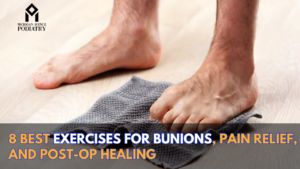Bunions, those pesky bumps that form at the base of the big toe, can cause discomfort and affect mobility. But fear not! There are effective bu treatments available to alleviate the pain and get you back on your feet.
10 Solutions for Bunion Treatment
1. Understanding Bunions
Bunions are bony bumps that develop at the joint of the big toe, causing it to push against the adjacent toe. This misalignment results in pain and discomfort, especially when wearing shoes or walking for extended periods.
2. Causes of Bunions
Several factors contribute to the development of bunions, including genetics, wearing ill-fitting shoes, and foot injuries. Additionally, certain foot deformities and conditions like arthritis can increase the likelihood of bunions.
3. Identifying Symptoms
Symptoms of bunions include pain, swelling, redness, and restricted movement of the big toe. In severe cases, corns and calluses may develop over the affected area due to friction from footwear.
4. Prevention Tips
To prevent bunions, opt for shoes with a wide toe box and low heels to reduce pressure on the toes. Incorporating stretching exercises and wearing orthotic inserts can also help maintain proper foot alignment.
5. Non-Surgical Treatments
Non-surgical approaches to bunion treatment focus on relieving pain and inflammation. This includes applying ice packs, taking over-the-counter pain relievers, and using padding or splints to cushion the bunion and reduce friction.
Also Read :
6. Footwear Modifications
Choosing footwear with ample room for the toes and proper arch support is essential for bunion sufferers. Avoid high heels and narrow, pointed shoes, as they can exacerbate bunion discomfort and accelerate progression.
7. Pain Management Techniques
Various pain management techniques such as massage, physical therapy, and foot exercises can help alleviate bunion pain and improve flexibility and strength in the foot muscles.
8. Surgical Options
In cases where conservative treatments fail to provide relief, surgical intervention may be necessary. Bunion surgery aims to realign the toe joint, remove the bony protrusion, and correct any associated deformities.
9. Post-Surgery Care
Following bunion surgery, patients will require a period of rest and recovery. It’s essential to follow post-operative instructions carefully, including keeping the foot elevated, avoiding weight-bearing activities, and attending follow-up appointments.
10. Lifestyle Adjustments for Long-Term Relief
To prevent bunions from recurring, make lifestyle adjustments such as maintaining a healthy weight, practicing good foot hygiene, and wearing supportive footwear. Regular check-ups with a podiatrist can also help monitor foot health and address any concerns promptly.
Frequently Asked Questions
1. Can bunions go away on their own?
No, bunions typically do not resolve on their own and may worsen over time without proper treatment.
2. Are bunions only caused by wearing high heels?
While wearing high heels can contribute to the development of bunions, genetics and foot structure also play significant roles.
3. How long does it take to recover from bunion surgery?
Recovery time varies depending on the type of surgery performed, but most patients can expect to resume normal activities within 6-8 weeks.
4. Is bunion surgery painful?
While discomfort is common following bunion surgery, pain can be managed effectively with medication and proper post-operative care.
5. Can bunions be prevented?
While bunions cannot always be prevented, wearing comfortable, supportive shoes and practicing good foot care can help reduce the risk of developing bunions.
Bunions may be a pain in the foot, but with the right treatment and lifestyle adjustments, you can find relief and get back to enjoying your daily activities without discomfort. Remember to consult with a healthcare professional for personalized advice and treatment options tailored to your specific needs.




